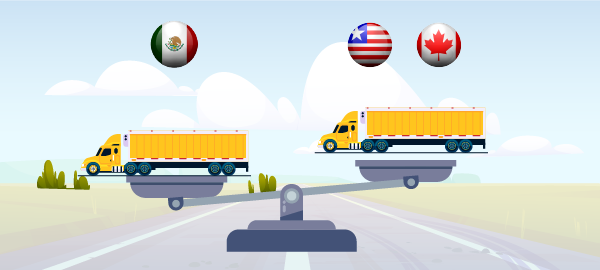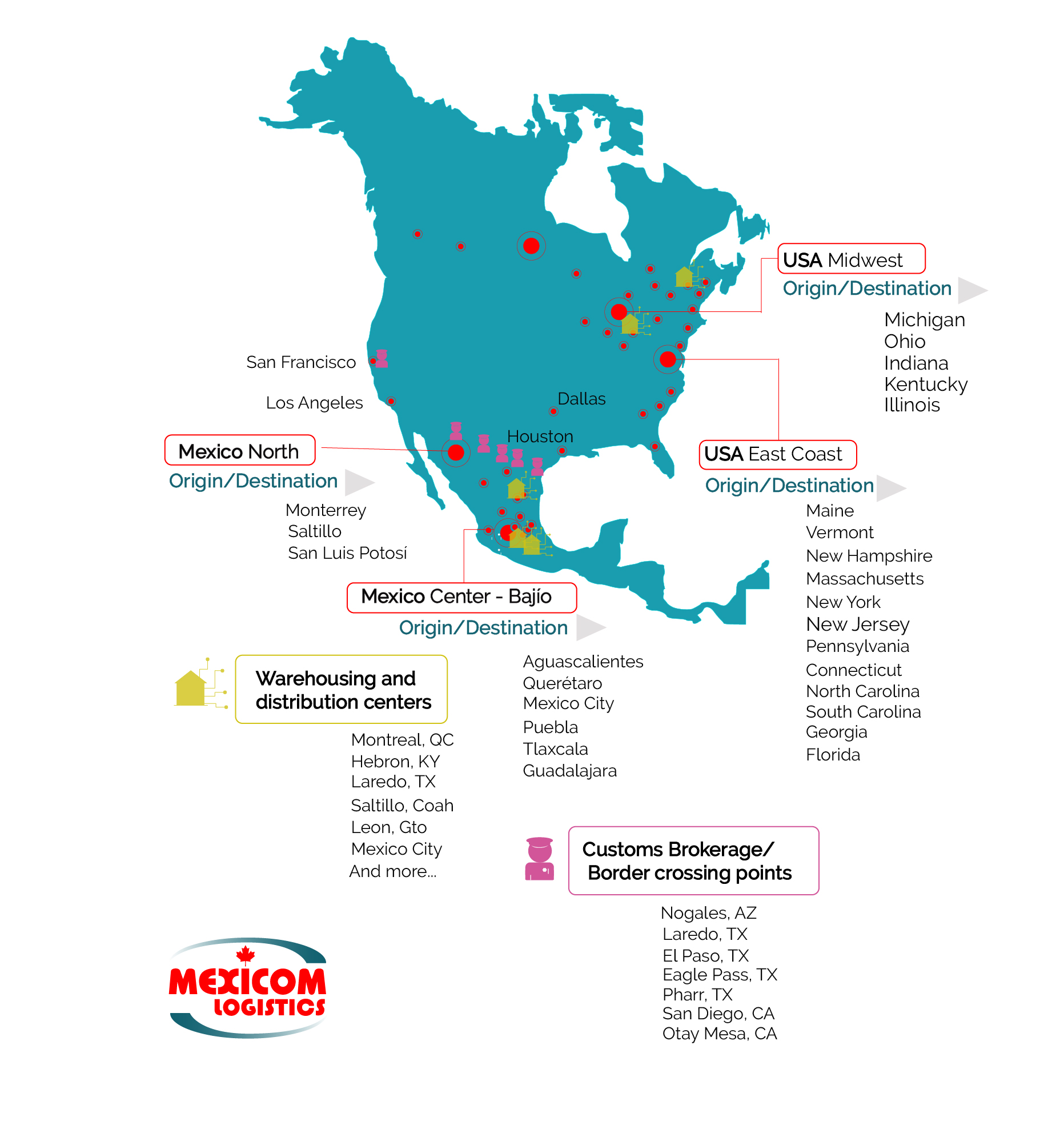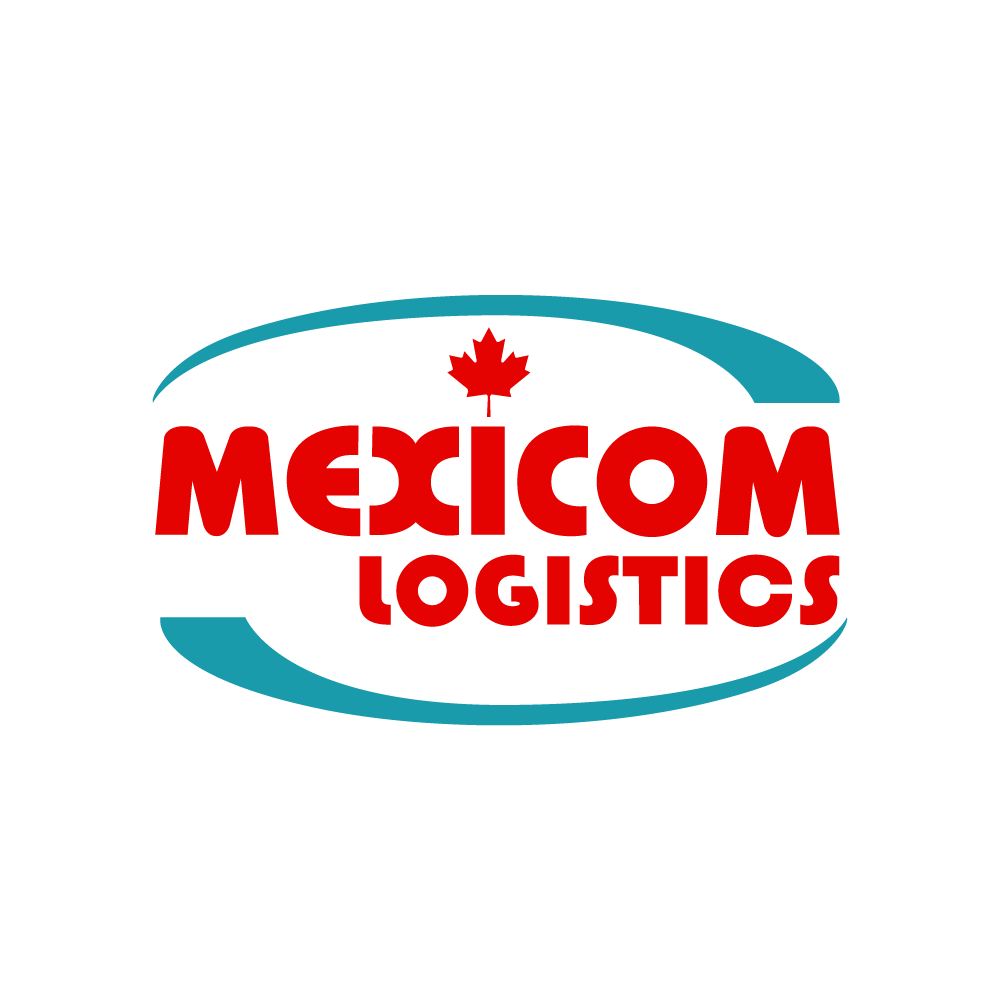Interesting facts about the differences in the freight transport in Canada, the United States and Mexico
The social, climatic, linguistic and economic diversity of North America frames the commercial relations that are established between the countries in the region. Of course, these differences are reflected in the transportation of goods, which gives life to the vibrant economy of North America. In this post, we present some of the differences that exist in the transport of goods in Mexico, the United States, and Canada.
Very different ways to verify the quality of carriers

A key component that will determine the quality of ground transportation of merchandise is the selection of suitable and reliable carriers. How do shippers or freight forwarders determine the quality of carriers in the United States and Canada and in Mexico? The methods are very different.
While in the United States the Safety and Fitness Electronic Records (SAFER) System, offers the safety profiles of American and Canadian carriers, in Mexico there is no similar system.
The US system gives access to carriers information such as identification, type of merchandise, rating, as well as data about accidents, fines, and more. In this way, through the consultation of the system, it is possible to know the level of reliability of the carrier. In Mexico, such a system simply does not exists.
So, how do shippers or freight forwarders know which Mexican carriers are the most reliable?
There are several ways:
1) Carriers must be part of C-TPAT, if the carrier is part of this United States government program, it is guaranteed that it complies with adequate safety rules and procedures and are reliable.
2) Carriers must have 24/7 satellite tracking units. This provides the security of knowing where the unit is located at all times and preventing suspicious events, such as unplanned route changes.
3) Experience, experience, experience. Throughout the years and after making thousands of trips through North America with Mexican carriers, freight forwarders are able to identify to which carriers trust their customers loads. Freight forwarders such as Mexicom Logistics have specialized departments that are dedicated to maintaining relations with transportation providers and giving a rating to carriers. This internal information of each company is part of the added value offered by hiring a freight forwarder.
Mexico is the country that works the most hours in the world
According to the most recent information of the Organization for Economic Cooperation and Development, Mexico is the country that works the most hours in the world, with 2200 hours worked per year per worker in 2018. Canada reported 1695 hours worked per worker per year in 2017 and the United States had 1780 in the same year. This is a reality that is reflected in the transport and logistics sector.
In the United States and Canada, and recently in Mexico, there are regulations that establish the mandatory rest time for drivers of freight transport. In general: In Canada a driver must drive a maximum of 13 hours per day or per work shift. To return to driving after a work shift, you must spend 8 consecutive hours. For its part, in the United States a driver can drive for a maximum of 11 hours after 10 consecutive hours out of service. In addition, a 30-minute break should be taken within each 8-hour driving period. Finally, in Mexico, the maximum driving time is 14 hours, after which the driver must take an 8-hour break. In addition, you should take a break of 30 minutes every 5 hours.
Although there is legislation, in Mexico drivers do not have the same precise control over their work hours as they do in the United States and Canada, through the e-log. That is why it is not uncommon to see drivers who work more hours than those marked in the regulations. Likewise, it is common to observe that logistics teams in Mexico request tracking of loads very late at night, while logistics coordinators in Canada and the United States frequently work just during the regular work hours.
Mexicans are not familiar with the Seasonal Weight Restrictions that exist in the US and Canada
 Canada and the United States are among the countries that reach the coldest temperatures, they are located in the fifth and sixth place worldwide respectively. That is why the regulations in terms of transport equipment differ from those that can be found in a country like Mexico, which maintains temperate or high temperatures almost all year in the vast majority of its territory.
Canada and the United States are among the countries that reach the coldest temperatures, they are located in the fifth and sixth place worldwide respectively. That is why the regulations in terms of transport equipment differ from those that can be found in a country like Mexico, which maintains temperate or high temperatures almost all year in the vast majority of its territory.
During the spring there is a process of defrosting that causes the pavement to weaken. For this reason, some American states and some Canadian provinces have adopted seasonal weight restrictions, which consist of reducing the permitted load limits during the defrosting period. The dates when the permitted weight is reduced vary depending on the weather conditions and the type of road.
In Mexico, the maximum weight allowed for a load has no variation throughout the year. That is why it is often surprising for Mexican customers that in one month the carrier has been able to transport its cargo in a single Dry Van and the following month it will not be possible to do the same, due to excess of weight. The efficient logistics coordination of freight transport across North America requires the recognition and forecasting of all the variables that impact the transportation process.
The Mexican and Canadian winter paradox
Living in a country where people enjoy mild temperatures most of the year, Mexicans are neither accustomed nor equipped to face extreme temperatures. In the north of Mexico, snowfalls with temperatures of minus 5 degrees provoke true chaos that paralyzes roads, airports, and schools, while in Canada they come to report temperatures of -40 degrees centigrade that, although they delay the shipment of goods, they do not paralyze the cities.
Differences in the height limits for loads in Mexico, the US and Canada
More about this subject in the following article:
Trucking Legal Height Limits in Canada, the US and Mexico Map
At Mexicom Logistics we are experts in ground freight transportation between Mexico, the United States, and Canada.

INFO@MEXICOMLOGISTICS.COM | + 1 514 667 0174
Sources
https://data.oecd.org/emp/hours-worked.htm
https://safer.fmcsa.dot.gov/
https://oversize.io/regulations/frost-laws-by-state
https://www.transports.gouv.qc.ca/fr/entreprises-partenaires/ent-camionnage/degel/Pages/Periode-de-degel.aspx
https://mdotjboss.state.mi.us/APSWB/searchBySpringWeight.htm?year=2019#2226









